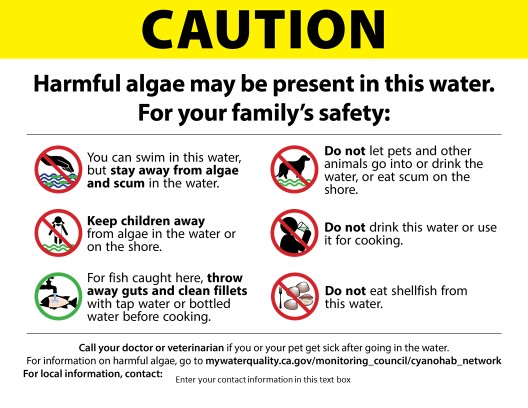Frequently Asked Questions about Freshwater and Estuarine Harmful Algal Blooms
What are cyanobacteria and harmful algal blooms?

Cyanobacteria (also known as blue-green algae) and algae occur in freshwater and estuarine waterbodies. Algae and cyanobacteria have been around for billions of years and are natural components of ecosystems. They perform many roles that are vital to our aquatic communities, by being a food source and producing oxygen. However, when certain conditions are favorable for these organisms, algae and cyanobacteria can rapidly grow causing “blooms.”
Algae and cyanobacteria can produce harmful compounds, such as toxins and taste and odor compounds, that cause health risks to humans and animals. When blooms pose a risk to humans, animals, and the environment, they are referred to as harmful algal blooms (HABs). Some algae grow attached to the bottom (benthic) and can form algal mats. For more information, see FAQs on toxic algal mats.
Algae and cyanobacteria can produce harmful compounds, such as toxins and taste and odor compounds, that cause health risks to humans and animals. When blooms pose a risk to humans, animals, and the environment, they are referred to as harmful algal blooms (HABs).
How do I know if there is a HAB in the water?
Sometimes the bloom is easily visible, forming a “scum” or discoloration on the water surface. Other times, it is less visible, floating beneath the surface or on the bottom of a water body (benthic). Blooms can appear green, blue, yellow, red, or brown. Cyanotoxins, produced by cyanobacteria, cannot be visually detected in water or tissues. Several guidance documents are available to aid identification of algae and cyanobacteria (Fact Sheet & HAB Field Guide - Visual Guide to Observing Blooms (2017)), and the California Freshwater HAB Field Guide is available to assist in monitoring.
Where and when are HABs occurring in CA?

Voluntarily reported HABs are posted on the HAB Reports Map. The number of submitted reports tracked from 2016-2019, as described in the table below, increased by 26% in 2019. In some areas, the duration of HABs are increasing from predominantly summer blooms to year-round blooms in some areas.
| Number of voluntary reports submitted to the online bloom reporting tool from 2016-2023 | ||||||||
|---|---|---|---|---|---|---|---|---|
| 2016 | 2017 | 2018 | 2019 | 2020 | 2021 | 2022 | 2023* | |
| Total reports | 91 | 181 | 190 | 241 | 370 | 603 | 684 | 468 |
*The 2023 hydrological year was unprecedented, with 141% of the average precipitation throughout the state, ending the state's driest consecutive three-year period, with one of the snowiest years on record, which likely had an impact on the growth of harmful algal blooms.
What causes HABs?
Increased inputs of nutrients like nitrogen and phosphorus (from fertilizers and human or animal wastes), promote cyanobacterial growth and can lead to increased occurrences of HABs. Low flows, stagnant water, increased intensity and duration of sunlight, and sustained high temperatures create the ideal conditions for HABs. Current research suggests that the rising temperatures and changing precipitation patterns caused by climate change are a catalyst for their growth.
What are the possible health concerns of HABs?
Cyanotoxins and algal toxins pose risks to the health and safety of people and pets, drinking water, and recreating in water bodies affected by blooms. They can also accumulate in fish and shellfish to levels posing threats to people and wildlife. Pets, especially dogs, are susceptible to HABs because they swallow more water while swimming and playing in the water, and are also less deterred by green, smelly water that may contain HABs. Learn more about Human Health Impacts, Domestic Animal Impacts and Fish and Wildlife Impacts.

What guidelines does California use for HABs?
Currently, there are no federal or state regulatory standards for cyanotoxins in recreational waters or drinking water. Participating state agencies have developed suggested voluntary guidance for responding to HABs in recreational waters. The Department of Public Health, local health departments, and water body managers are encouraged to use this guidance for posting water bodies when HABs pose a health threat. Guidance is also available for addressing cyanotoxins in drinking water.
What can I do?
- Report any suspected HAB or potential HAB-related illness.
- Practice Healthy Water Habits at your local lake, river, or stream!
- Help reduce nutrients in in your local lake, rivers, and streams by modifying some daily activities.
Where can I find info on marine HABs?
HABs occurring in marine (coastal) areas are outside of the scope of this Portal. Please refer to the Cal HAB Monitoring and Alert Program (HABMAP | California HABMAP (calhabmap.org)) that provides information on marine HABs. In addition, information on marine biotoxins in fish and shellfish are provided by CA Department of Public Health, OEHHA, and CA Department of Fish and Wildlife.

